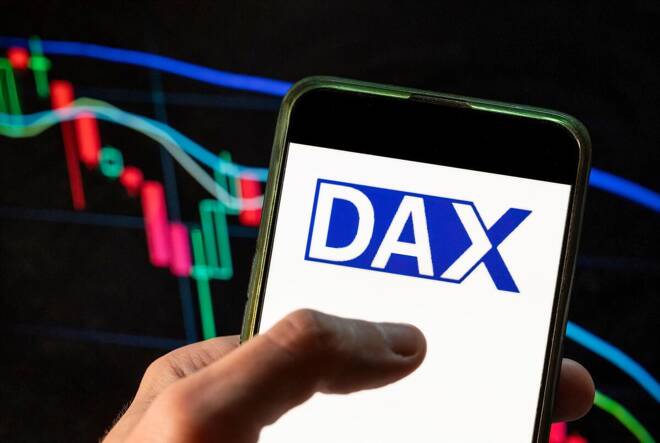Advertisement
Advertisement
DAX Index Today: The Middle East, US Retail Sales, and Eurozone Industrial Production
By:
Key Points:
- The DAX fell by 0.13% on Friday, April 12, ending the session at 17,930.
- Geopolitical tensions, trade data from China, and consumer sentiment numbers from the US impacted buyer demand for DAX-listed stocks.
- On Monday, the Middle East, industrial production numbers for the Eurozone, and US retail sales will be in focus.
The Overview of the DAX Performance
The DAX fell by 0.13% on Friday. Following a 0.79% loss on Thursday, the DAX ended the session at 17,930.
China Trade Terms Deteriorated in March
Economic indicators from China contrasted with recent manufacturing sector PMI numbers, signaling the need for a stimulus package. Exports declined 7.5% year-over-year in March after rising 5.6% in February. Imports fell by 1.9% after declining 8.2% in February. The US dollar trade surplus narrowed from $125.16 billion to $58.55 billion.
Improving US-China relations could influence trade terms. Nevertheless, the larger-than-expected fall in exports highlighted a weak demand environment.
Survey of Professional Forecasters Supported a June ECB Rate Cut
On Friday, the ECB released the Survey of Professional Forecasters. Forecasters expected economic activity to improve during 2024. Significantly, forecasters projected inflation to fall to 2.4% in 2024 and 2.0% in 2025. The inflation outlook supported investor bets on a June ECB rate cut.
US Economic Calendar: US Consumer Inflation Expectations
On Friday, US consumer sentiment numbers warranted investor attention. The Michigan Consumer Sentiment Index declined from 79.4 to 77.9 in April. Moreover, the Michigan Inflation Index increased from 2.9% to 3.1%, impacting investor bets on a June Fed rate cut.
On Friday, the Nasdaq Composite Index slid by 1.62%. The Dow and the S&P 500 saw losses of 1.24% and 1.46%, respectively. Rising geopolitical tensions in the Middle East contributed to the losses. Warnings of Iran planning an attack on Israel impacted buyer demand for riskier assets.
The Friday Market Movers
The risk-off sentiment impacted auto and tech stocks. BMW and Porsche saw losses of 2.14% and 0.98%, respectively. Mercedes Benz Group declined by 0.49%, while Volkswagen bucked the trend, advancing by 0.57%.
Infineon Technologies fell by 2.26%, with SAP ending the session down 0.09%. Investors reacted to the sliding investor bets on a June Fed rate cut.
However, Rheinmetall AG advanced by 1.95% on rising geopolitical tensions.
Eurozone Industrial Production and the ECB
On Monday, industrial production numbers for the Eurozone will draw investor interest. Economists forecast industrial production to increase by 1.1% in February after sliding by 3.2% in January.
Better-than-expected numbers could support expectations of an improving economic outlook. However, investors should monitor news from the Middle East. The threat of retaliation to the Saturday attack on Israel could impact buyer demand for riskier assets.
Moreover, ECB commentary also needs consideration. ECB Chief Economist Philip Lane is on the calendar to speak.
US Economic Calendar: Retail Sales and the Fed
On Monday, US retail sales figures for March could further influence the Fed rate path. Hotter-than-expected numbers could end bets on a June Fed rate cut.
Economists forecast retail sales to increase by 0.3% in March after rising by 0.6% in February.
Other stats include the NAHB Housing Market Index and NY Empire State Manufacturing Index numbers. However, the stats will likely play second fiddle to the retail sales data.
Beyond the numbers, earnings results also need consideration. Goldman Sachs (GS) is on the calendar to release earnings results.
Near-Term Outlook
Near-term trends for the DAX will likely hinge on updates from the Middle East, central bank chatter, and earnings results. However, rising geopolitical tensions would likely overshadow economic indicators and earnings results.
In the futures, the DAX and the Nasdaq Mini were up 13 and 51 points, respectively.
DAX Technical Indicators
Daily Chart
The DAX hovered above the 50-day and 200-day EMAs, affirming the bullish price signals.
A DAX return to the 18,000 handle could support a move to the 18,250 handle. A break above the 18,250 handle could give the bulls a run at the April 2 all-time high of 18,567.
The Middle East, central bank commentary, corporate earnings, and the US economic calendar need consideration.
However, a fall through the 17,850 handle would bring the 50-day EMA into play.
The 14-day RSI at 46.57 indicates a DAX drop below the 17,615 support level before entering oversold territory.
4-Hourly Chart
The DAX remained below the 50-day EMA while holding above the 200-day EMA, affirming the bearish near-term but bullish longer-term price signals.
A return to the 18,000 handle would support a move to the 50-day EMA. A break above the 50-day EMA could bring the 18,500 handle into play.
Conversely, a fall through the 17,800 handle could give the bears a run at the 17,615 support level.
The 14-period 4-hour RSI at 40.09 suggests a DAX fall through the 17,800 handle before entering oversold territory.
About the Author
Bob Masonauthor
With over 28 years of experience in the financial industry, Bob has worked with various global rating agencies and multinational banks. Currently he is covering currencies, commodities, alternative asset classes and global equities, focusing mostly on European and Asian markets.
Latest news and analysis
Advertisement
